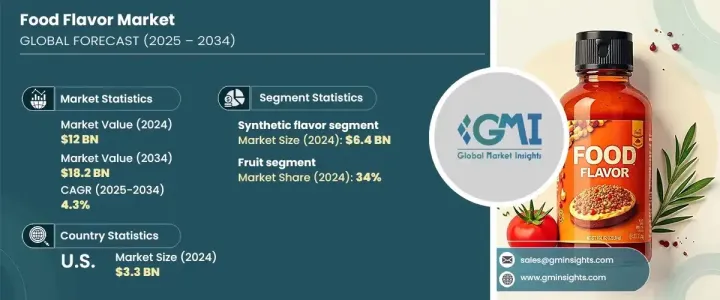
세계의 식품 향료 시장은 2024년에 120억 달러의 규모에 이르렀으며, 2025년부터 2034년에 걸쳐 4.3%의 연평균 성장률(CAGR)로 성장할 것으로 전망됩니다. 이러한 꾸준한 성장은 인공 첨가물 대신 더 건강하고 자연스러운 대안을 선호하는 소비자의 선호도가 진화함에 따라 주도되고 있습니다. 건강과 웰빙에 대한 인식이 높아지면서 더 많은 소비자가 식물과 동물성 원료에서 추출한 천연 맛을 선호하고 있습니다.

클린 라벨 제품(성분 표시가 투명한 식품)에 대한 수요 증가가 이러한 변화에 기여하고 있습니다. 또한 지속 가능성에 대한 관심이 높아지면서 천연 향료가 더 환경 친화적인 것으로 여겨지는 것도 시장의 성장에 도움이 되고 있습니다. 소비자들이 더 높은 투명성을 추구함에 따라 더 안전하고, 더 진실하며, 더 건강한 재료로 만든 제품을 요구하고 있습니다. 이러한 천연 재료에 대한 수요는 식품에 천연 재료를 사용하도록 장려하는 전 세계 당국의 규제 지원으로 더욱 촉진되고 있습니다.
| 시장 범위 | |
|---|---|
| 시작 연도 | 2024년 |
| 예측 연도 | 2025-2034년 |
| 시작 금액 | 120억 달러 |
| 예측 금액 | 182억 달러 |
| CAGR | 4.3% |
식품 알레르기와 민감성 발생률이 증가하는 것도 천연 향료의 인기를 높이는 또 다른 요인으로, 천연 향료는 일반적으로 합성 향료보다 안전한 대안으로 인식되고 있습니다. 기업들은 더 깨끗하고 건강에 좋은 옵션으로 혁신을 추진하고 있습니다. 건강을 생각하는 소비자가 증가함에 따라 이러한 시장 트렌드는 둔화될 기미가 보이지 않습니다.
식품 향료 시장은 향료의 유형에 따라 천연과 합성으로 구분됩니다. 비용 효율성, 일관성, 긴 유통기한으로 인해 가공 식품 및 음료 생산에 널리 사용되고 있습니다. 그러나 천연 및 클린 라벨 제품에 대한 소비자 선호도가 높아지면서 합성 향료에 대한 도전이 제기되고 있습니다.
향료 카테고리별로는 과일 향이 2024년 시장 점유율의 34%를 차지하며 선두를 달리고 있습니다. 이러한 인기는 음료, 제과, 유제품, 스낵 등 다양한 용도로 사용되는 과일 향의 자연스러운 단맛과 다용도성 때문인 것으로 보입니다. 또한 이국적인 열대 과일 맛에 대한 소비자의 관심 증가는 글로벌 요리 트렌드와 진화하는 맛 선호도를 반영합니다.
혁신적이고 개인화된 맛 솔루션을 점점 더 많이 찾는 역동적이고 다양한 소비자층에 힘입어 2024년 미국 식품 향료 시장만 33억 달러에 달했습니다. 간편 식품의 증가와 함께 클린 라벨 및 천연 재료에 대한 수요가 증가하면서 이 지역에서 고급 향료 기술의 채택이 촉진되고 있습니다. 또한, 업계 선도 기업의 강력한 입지와 연구 개발에 대한 막대한 투자가 미국 시장의 지속적인 성장과 지배력을 뒷받침하고 있습니다.
The Global Food Flavor Market reached a value of USD 12 billion in 2024 and is expected to grow at a steady CAGR of 4.3% from 2025 to 2034. This steady growth is driven by evolving consumer preferences for healthier, more natural alternatives to artificial additives. As awareness about health and wellness increases, more consumers are gravitating toward natural flavors derived from plant and animal sources. These natural options are viewed as healthier compared to synthetic flavors, which are often associated with artificial ingredients.

The rising demand for clean-label products-foods with transparent ingredient lists-is contributing to this shift. In addition, the market is benefiting from a greater focus on sustainability, with natural flavors often seen as more environmentally friendly. As consumers seek greater transparency, they're demanding products made with ingredients that are safer, more authentic, and healthier. This drive for natural options is being further fueled by regulatory support from authorities worldwide that encourage the use of naturally sourced ingredients in food products.
| Market Scope | |
|---|---|
| Start Year | 2024 |
| Forecast Year | 2025-2034 |
| Start Value | $12 Billion |
| Forecast Value | $18.2 Billion |
| CAGR | 4.3% |
The growing incidence of food allergies and sensitivities is another factor driving the popularity of natural flavors, as they are generally perceived as safer alternatives to synthetic options. The expanding global demand for plant-based and organic foods also supports the growing interest in naturally derived flavors. Consumers are increasingly seeking flavors that align with their evolving dietary preferences, pushing companies to innovate with cleaner, more wholesome options. With the rise in health-conscious consumers, this market trend shows no signs of slowing down. Food manufacturers are expected to continue shifting toward natural and clean-label products, prompting flavor companies to diversify their offerings.
The food flavor market is segmented by flavor type into natural and synthetic. In 2024, synthetic flavors dominated the market, generating USD 6.4 billion in revenue. Their cost-effectiveness, consistency, and long shelf life make them popular choices in processed food and beverage production. However, the growing consumer preference for natural and clean-label products is presenting challenges for synthetic flavors. This shift in consumer behavior has encouraged the development of hybrid flavors, combining the benefits of both synthetic and natural ingredients.
In terms of flavor categories, fruit flavors were the leading segment, accounting for 34% of the market share in 2024. This popularity can be attributed to the natural sweetness and versatility of fruit flavors, which are used in a wide range of applications, including beverages, confectionery, dairy, and snacks. Additionally, the increasing consumer interest in exotic and tropical fruit flavors is reflective of global culinary trends and evolving taste preferences.
The U.S. food flavor market alone generated USD 3.3 billion in 2024, driven by a dynamic and diverse consumer base that increasingly seeks innovative and personalized flavor solutions. The growing demand for clean-label and natural ingredients, combined with the rise of convenience foods, is fueling the adoption of advanced flavor technologies in the region. Furthermore, the strong presence of leading industry players and significant investments in research and development are supporting the U.S. market's ongoing growth and dominance.